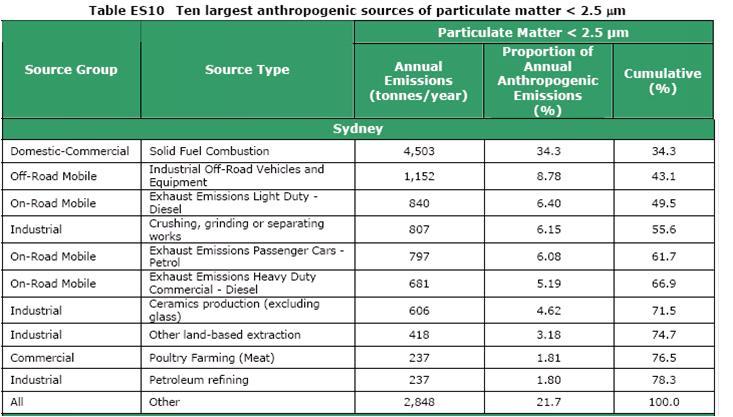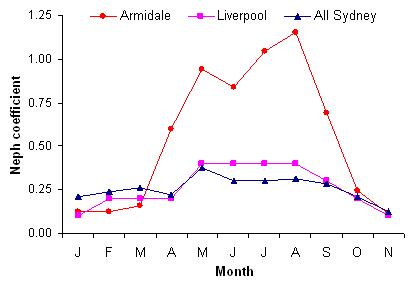Latest NSW Emissions Inventory – woodheaters are Sydney’s largest single
source of health-hazardous PM2.5
Table ES10 (below) from Technical Report 1 of the latest NSW
emissions inventory released in 2007 shows that woodheaters are the largest single source of
health-hazardous PM2.5 in Sydney – 4,503 tonnes per year
– 5.6 times as much as the 797 tonnes from passenger cars. Woodheaters are also the largest single source of PM2.5 in
the Greater Metropolitan Region (GMR), emitting more PM2.5 than
off-road industrial vehicles, on-road vehicles or coal mining.
Woodsmoke contains many of the same and similar chemicals as tobacco smoke, including
PAH , and is associated with the same and similar health problems, including heart and lung diseases, mouth, throat and lung cancers and middle ear infections. PAH from air pollution cause genetic damage in babies; PM2.5 exposure also increases the risk of cot deaths. Because woodsmoke is emitted in residential areas, where people live and spend time with their
families, it is likely to cause a lot more health damage than emissions at more
remote industrial sites.
Based on DECC’s estimated health costs of $132
per kg of PM2.5 (Table 6.3.1), the average new passenger car in Sydney costs
$20 per year, but the average new woodheater has
health costs of about $2,000 per year. When faced with similar data, cities
such as Christchurch, NZ, banned the installation of
woodheaters in all new houses and those with non-polluting heating . Heaters
with emissions ratings more than 1.0 g/kg have to be removed after 15 years use.
Contrast this with NSW, where despite estimated health costs of
$2,000 per woodheater per year in Sydney, there is little or no effort to
discourage the installation of new heaters with emissions ratings up to 4
times worse than permitted in Christchurch. Recommendations to halve the AS/NZ emissions limit were vetoed by the AHHA as representatives of the woodheater manufacturers. New Zealand introduced strict health-based standards for all woodheaters
installed on properties less than 2 ha. Unfortunately, Australian governments have failed to take similar measures to protect our health.
With PM2.5 in general estimated to increase
mortality by 6% (and woodsmoke by 8%) and fine
particle air pollution causing the premature
deaths of up to 1400 Sydneysiders every year, we we call on governments to
introduce policies to slash emissions from this the largest source of
health-hazardous PM2.5 pollution as a matter of urgency.
When the government introduced strict emissions limits, PM2.5 from diesel
cars in Australia was slashed by 97% - from 0.75 g/km in 1989 to 0.025 g/km in
2007. Australian governments should, like those responsible for air pollution
reduction programs in NZ, demonstrate concern for our health, by setting strict
emissions limits to ensure the average new woodheater is no more polluting than
the average new car, a moratorium on installing new woodheaters until the health-based limit has been agreed, and policies
(e.g. a levy on use of excessively polluting heaters to subsidise their replacement with non-polluting heating) to reduce the current unacceptably high health costs of woodheating as quickly as possible.

AHHA vetoed reduction in emissions limit
In the Aug 07 issue of Clean Air Dr John Todd explained the failure of Standards Australia to set a health-based emissions limit: “It is Standards' policy that any of the major stakeholders (such as industry or community representatives) can veto changes in the standard. This makes substantive change difficult to achieve, for example changes to methods that might involve additional costs to industry.”
The most recent Standards Australia Committee meeting (March 2007) discussed plans to research a new lab test simulating real-life emissions. The majority of delegates recommended halving the current emissions limit to 2 g/kg as an interim measure until this work is completed. However, the AHHA (representing some woodheater manufacturers) objected, so no change was made.

Pollution even worse in small towns such as Armidale
Many people think that small towns such as Armidale (and even larger cities such as Christchurch, where main source of pollution is from domestic heating) are less polluted than large metropolitan areas such as Sydney. The graph shows that this is indeed true in summer – in January, February and March, Armidale’s pollution is about half that of Sydney. But as soon as people start using woodheaters in April, average monthly pollution levels rise dramatically to several times those in Sydney, even suburbs such as Liverpool where some people use woodheaters.
Levels of health-hazardous PAH are also much higher - 8.62 ng/m3, compared to 4.47 in Sydney in winter, and summertime averages of 0.62 (Sydney) and 0.28 (Armidale).
PM2.5 the most health-hazardous pollutant
Current research shows that PM2.5, especially those from diesel engines or coal or biomass burning, are most closely related to adverse health effects such as premature mortality. A 197-page expert report from the UK concludes the best estimate is that an increase of 10 ug/3 in PM2.5 increases death rates by 6%, but other analyses suggest the effect could be substantially higher. The strongest indication that the effect is causative is that when communities reduce their PM2.5 pollution, death rates fall and people suffer fewer respiratory illnesses.
The first study to report a relationship between PM2.5 pollution and death rates was the six cities study. Some of the cities reduced their PM2.5. Prof Joel Schwartz described the continuing follow-up in 2007: "In cities where particle concentrations fell substantially, mortality rates fell substantially, whereas in cities where there was little change in particle concentrations, the mortality rate changed little.
Dublin reduced its PM2.5 pollution in September 1990 by banning non-smokeless coal. In the 6 years after the ban, thee were 15.5% fewer respiratory and 10.3% fewer cardiovascular deaths compared to the previous 6 years. Thus more than 2,000 lives were saved in the first 6 years of the ban
In Switzerland, where use of wooheaters is common, pollution has been reduced. A decline of 10 ug/m3 in annual PM10 exposure reduced children’s chronic coughs by 35%,bronchitis by 34%, common cold by 22%, nocturnal dry cough by 30% and conjunctivitis symptoms by 19%. The researcher reported that there was "no threshold of adverse effects of PM10 was
apparent because we observed the beneficial effects for relatively small changes of rather moderate airpollution levels."
Health effects of PAH
PAH or polycyclic aromatic hydrocarbons are one of the 5 air toxics considered in Australia's National Air Quality National Environment Protection Measure. Benzo-alpha-pyrene (BaP), featured in the "every cigarette is doing you damage" commercial is the best-known PAH. In New York, where BaP levels are less than 0.5 ng/m3, PAHs are linked to genetic damage in babies and
a lower mental development at age 3.
Woodsmoke the major source of PAH
Sydney's wintertime BaP averaged 0.46 ng/m3 (comparable or possibly higher than NY levels) 15 times average summer levels of 0.03 ng/m3. Total PAH in winter averaged 4.47 ng/m3, seven times Sydney's summer average of 0.62 ng/m3. National Pollutant Inventory data show that wood heaters emit 48% of PAH in the Sydney metropolitan airshed (44% and 67% in Melbourne and Canberra). Thus in Australia, woodheaters are a major source of BaP and PAH in our cities, generating wintertime levels similar to those in NY that were linked to genetic damage in babies and a lower mental development in toddlers. Armidale's wintertime BaP, averaging 1.3 ng/m3, much higher than NY or Sydney, is a serious concern for our health.

